Mammals of Jurong Lake Gardens
Plantain Squirrel
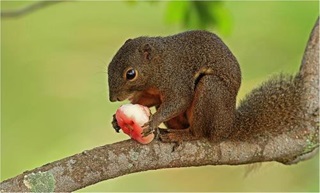 Photo credit: Loke Peng Fai Photo credit: Loke Peng Fai |
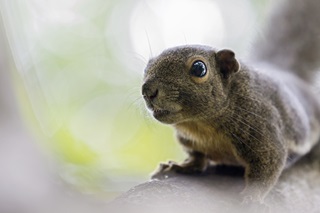 Photo credit: Loke Peng Fai Photo credit: Loke Peng Fai |
| Scientific name: | Callosciurus notatus |
| Common name: | Plantain Squirrel |
| Family: | Sciuridae |
 What does it look like?
What does it look like?
Plantain Squirrels are one of the most common native mammals in Singapore, alongside the Long-tailed Macaque. They have an orange belly with black and white stripes on their sides, which differentiates them from the less common Slender Squirrel.
 Ecology, Habitat and Distribution
Ecology, Habitat and Distribution
Diet and Behaviour
They mainly eat fruits and leaves, but will jump at the chance to have insects and bird eggs when available. They communicate via tail movements and vocalisations such as mating calls or anti-predator alerts, which are often mistaken for bird calls. They have different calls for different predators.
Where are they found?
They are common residents of our parks, gardens, mangroves and secondary forests. They are important seed dispersers in our forests and also serve as a food source for predators such as snakes and eagles. Their range stretches from southern Thailand across the Malay Peninsula to the islands of Borneo, Java and Sumatra.
Did you know?
There are two other native species of non-flying squirrels in Singapore: the Slender Squirrel and the Shrew-faced Ground Squirrel.
Smooth-coated Otter
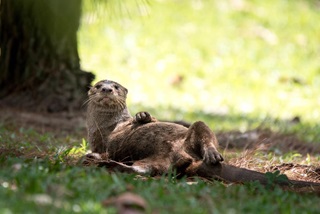 Photo credit: Jeremy Yeo Wei Liang (NParks) Photo credit: Jeremy Yeo Wei Liang (NParks) |
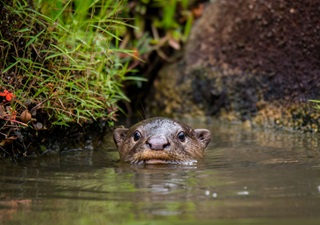 Photo credit: Kathleen Yap (NParks) Photo credit: Kathleen Yap (NParks) |
| Scientific name: | Lutrogale perspicillata |
| Common name: | Smooth-coated Otter |
| Family: | Mustelidae |
 What does it look like?
What does it look like?
Named after its short, smooth and sleek fur, Smooth-coated Otters are the larger of two otter species found in Singapore (the other being the Asian Small-clawed Otter, Aonyx cinerea), growing up to 1.2 m in body length. Its upperparts are greyish brown and its undersides are yellowish beige. It has a streamlined body adapted for swimming and fully webbed feet with prominent claws for catching prey.
 Ecology, Habitat and Distribution
Ecology, Habitat and Distribution
Diet and Behaviour
The Smooth-coated Otter’s main diet is fish, such as tilapia and catfish, but they also feed on frogs, crabs, birds and small rodents.
They are highly social animals that form family groups consisting of a monogamous mating pair and their pups. They have the potential to breed year-round, provided food and suitable habitats are available. While baby otters look extremely adorable, it is best to admire them from a distance as the mothers are very protective of their young, like all other wild animals.
Pups are born blind in hidden burrows and open their eyes after 10 days. They are taught to forage and swim in a few months and will stay with their parents for at least a year. Their average lifespan is about 10 years.
Where are they found?
Being semi-aquatic, they require both terrestrial and aquatic (usually freshwater) habitats to survive. Successful efforts in cleaning up our waterways have expanded their range from coastal mangroves to rivers, reservoirs and urban spaces on land. They can regularly be seen at Marina Bay, Pasir Ris Park, Sungei Buloh Wetland Reserve and Jurong Lake Gardens. Smooth-coated Otters are widely distributed in Pakistan, India, south China, the Malay Peninsula, Sumatra, Borneo and Java.
Did you know?
A family of about 15-16 otters frequents the waters of Jurong Lake Gardens. Otters are territorial between groups and will defend their space by marking areas on land with their spraint (otter poop, characterised by a distinct fishy smell and greenish brown jelly-like appearance).
 Conservation Status
Conservation Status
It is listed as Critically Endangered in the Singapore Red Data Book (2008). Threats that the otters face in Singapore include car traffic in urban areas and interactions with humans. Additionally, It is a protected species in many countries, being listed as Vulnerable by the IUCN and offered the highest protection level in international trade by being up listed to CITES Appendix I.
Common Fruit Bat
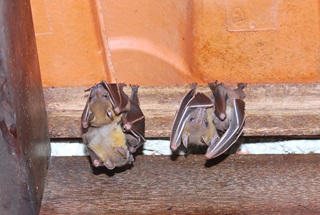 Photo credit: Daniel Ng (NParks) Photo credit: Daniel Ng (NParks) |
| Scientific name: | Cynopterus brachyotis |
| Common name: | Common Fruit Bat, Lesser Dog-faced Fruit Bat |
| Family: | Pteropodidae |
 What does it look like?
What does it look like?
The Common Fruit Bat has a dog-like face with a long muzzle and large eyes. It is about 7 cm from head to feet, making it one of the largest bat species in Singapore. It is brown in colour and has a reddish (male) or yellowish (female) collar. Their ears and wing bones have distinct white edges.
 Ecology, Habitat and Distribution
Ecology, Habitat and Distribution
Diet and Behaviour
These nocturnal creatures feed on nectar and fruits. They tend to roost in small groups in shaded areas during the day.
Where are they found?
They are found in both forest and urban habitats, in buildings, trees, palms and under leaves (e.g. banana leaves) during the day. They are widespread and common in Singapore.
They are distributed in Sri Lanka, Myanmar, South China, Indochina, the Philippines, Malaysia and western Indonesia.
Did you know?
Bats are divided into two main groups, megabats and microbats. Common Fruit Bats are megabats which are mainly fruit and nectar feeders. Microbats are much smaller in size and eat mostly insects and other small animals.
Bats are specially adapted to navigate using sound with a technique called echolocation. They emit ultrasonic sound waves from their mouths or noses which bounce off objects and prey as echoes, indicating their location. However, the Common Fruit Bat’s echolocation abilities are limited and it mainly uses vision and scent to locate food sources.
Long-tailed Macaque
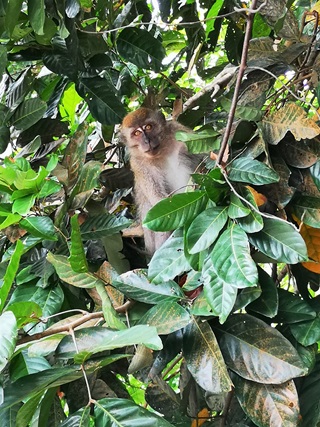 Photo credit: Li Tianjiao (NParks) Photo credit: Li Tianjiao (NParks) |
| Scientific name: | Macaca fascicularis |
| Common name: | Long-tailed Macaque |
| Family: | Cercopithecidea |
 What does it look like?
What does it look like?
Adults are generally the size of a small child at 45 cm from head to feet. They have long arms and legs, and a tail that is longer than their body. Their upperparts are olive brown and underparts are much paler. They have distinctive white eyelids and a greyish face.
 Ecology, Habitat and Distribution
Ecology, Habitat and Distribution
Diet and Behaviour
Long-tailed Macaques are omnivores that feed on both plants and animals, serving the important ecological role of dispersing seeds of plants in our nature reserves and nature areas. They are highly intelligent animals that mainly live in trees but also forage on the ground. They live in troops with both males and females with a clear dominance hierarchy (social ranking).
Where are they found?
Long-tailed Macaques are the most commonly seen monkeys in Singapore with about 1,500 individuals in the Central Catchment Nature Reserve and other parks, as well as on offshore islands such as Pulau Ubin. They are also found in neighbouring regions like southern Indochina, Myanmar, western Indonesia, Philippines and the Nicobar Islands.
Did you know?
Feeding the macaques alters their natural behaviour and makes them reliant on humans for food. This eventually leads to the display of aggressive behaviour by the macaques such as grabbing plastic bags and food containers from people. Human food can also cause upset stomachs in macaques and have a negative impact on their health. Instead, we should let macaques forage for their natural food in our rainforests, which would also help our forests regenerate.
Banner: Smooth-coated Otter. Photo credit: Kathleen Yap (NParks)


